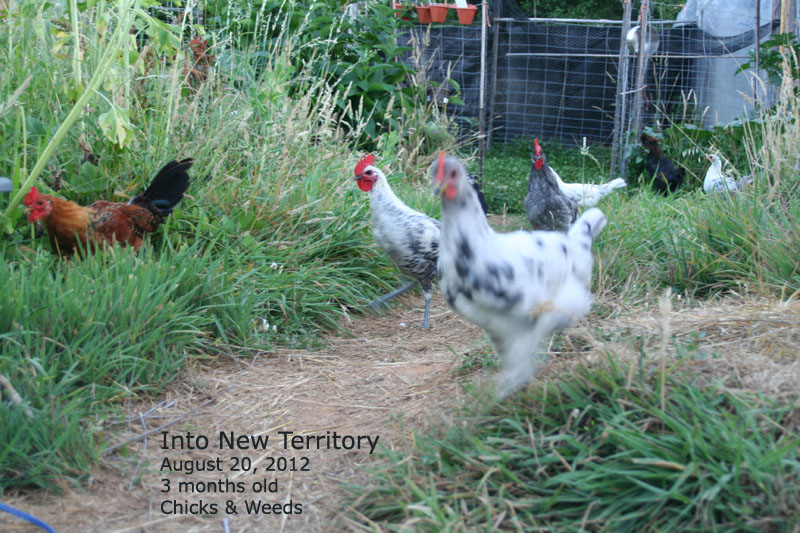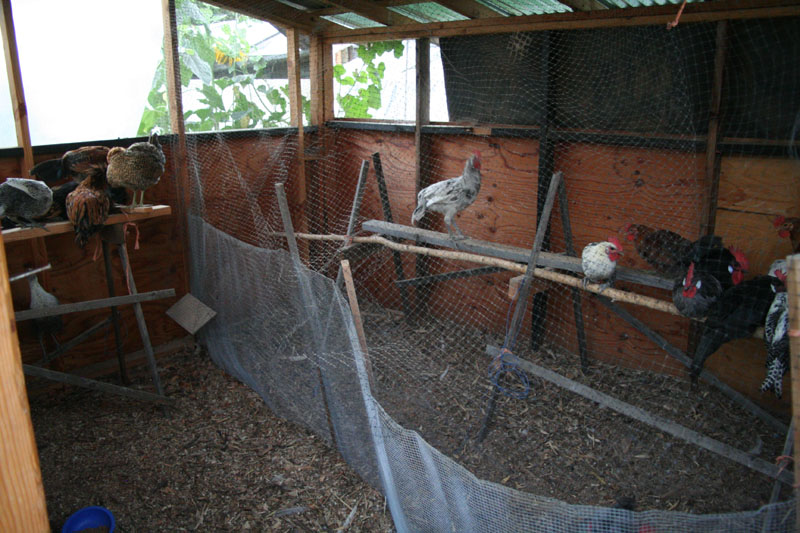Hahaha – I conclude after this afternoon’s little experiment: They seem to consider me a treat and food dispenser – much easier than to forage. Did I spoil them for good? Will they ever work by “working the soil”? They SEEMED to forage …..
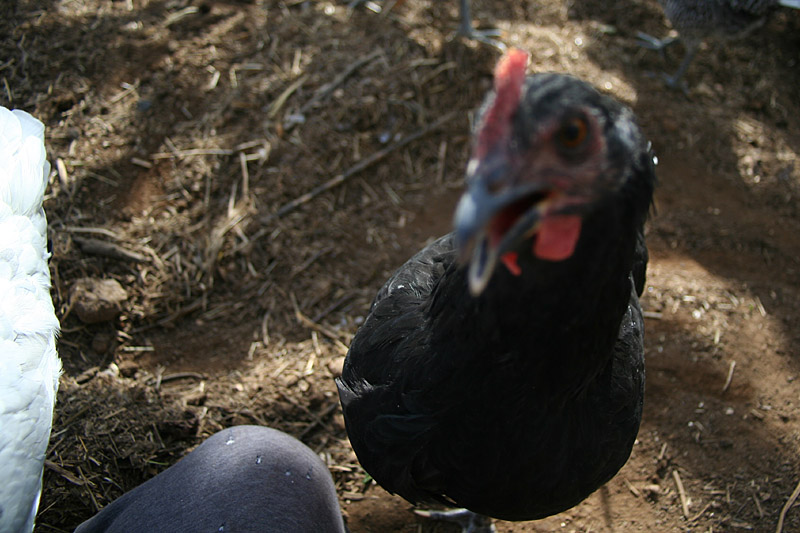
My goal is:
- Happy healthy free range and predator safe chickens who work for a living by composting, fertilizing and tilling.
- Chickens providing eggs for the family and some friends
- A beautiful bountiful all organic and no till (no commercial till that is) garden, both flower and food, with areas where chickens can meet humans 🙂 with it being a positive experience for both.
I am working on solving this: how to get them to be well fed AND work the ground, eliminating the need to weed and buy fertilizer come planting season next year – without having a chicken tractor or raised beds available?
Ok, these are my first ever chickens, a straight run of 26 light assorted chicks, now almost 4 months old. Since yesterday, the chicken coop is separated into 2 pens with a separate exit/entrance for the rooster group, which stays in the orchard area. That leaves the 9 hens (or pullets at this age) and 7 other cockerels in the compost run and garden field. That garden field yielded very little produce this year — I used no fertilizer at all and barely weeded. So I found out: this does NOT work AT ALL to get any vegetables worth mentioning, thought the beans did ok. But then, I kinda suspected it. Looking at the overgrown garden I wonder HOW ON EARTH is that gonna get chicken-tilled? Sure, the chicks pretty much got rid of all the compost run vegetation, but giving them access to the garden field has barely lefty a mark so far.
Ok, it really has been TOO HOT so far to do much foraging out there, and it is also much more open, and they definitely prefer protected areas.
The little experiment:
Today, at 4 pm, I went out there to check on them:
They came running, their crops were empty and they wanted food. Since after some consideration I know that there will neither be time nor resources for a proper chicken tractor this year, I did an experiment: I took a couple of hand-fulls of my night-time feed mix and threw it onto an area of about 1 square yard, right next to their current feeding area, where they get the kitchen scraps. They all eagerly went for it ….so I sat down in their old feed area, compost run 1, which I cleaned out yesterday. Wouldn’t you know it: they soon come over to where I was sitting and then – started gently pecking me – peck peck peck – the kind of peck that they know usually miraculously produces a delicious treat – only this time I didn’t have anything.
I went back to where I had thrown the grain/crumble mix and checked, just in case they had eaten it all – but NO — just a little “scratching with my fingers revealed PLENTY of grains still on the ground.
Did I spoil them for good?
That is expensive grain – not really an option chickies!!! I played mother chick (something I maybe should have done better and earlier ?) and showed them a couple of times that “scratching” does reveal food on the ground – BELOW the grasses – and some sure got it and were busy for a bit – there’s hope! Maybe????
Considering the garden weeding needs, an absence of a chicken tractor, I am now thinking to “till” without a chicken tractor by doing this:
just giving them their food in a new area each week – progressing at about a 1 x 4 foot area every couple of days, at least until the rain starts, after which they will do their compost work in a covered heavily mulched area.
I’ll let you know how it goes with the tilling by moving the feed area.
Here is the current chicken feeding schedule;
Chickens will get fed kitchen scraps in the morning after having been left out. The feeding will be in a designated square footage. This would be easier if one had raised beds, but as it is, we’ll do the best we can.
Chickens can free range forage ALL day, weather permitting.
They will get kitchen scraps (provided by the householders of this property) again in the late afternoon plus commercial soy free organic feed.
The feed is also available at night in the coop, just so they have something to do in the morning while they wait to be let out.
The goals again:
- Happy healthy free range and predator safe chickens who work for a living by composting, fertilizing and tilling.
- Chickens providing eggs for the family and some friends.
- A beautiful bountiful all organic and no till (no commercial till that is) garden, both flower and food, with areas where chickens can meet humans 🙂 and it being a good experience for all.
I am working on solving this: how to get them to be well fed AND work the ground, eliminating the need to weed and buy fertilizer come planting season next year – without having a chicken tractor or raised beds.
Will keep you posted.
…oh – 4 months – I better get some kind of a nest box soon …..

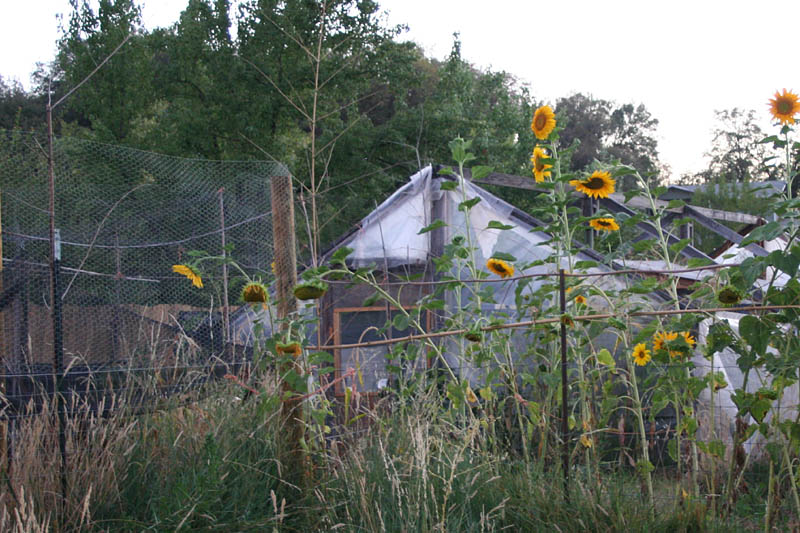 In addition to sun flowers, clover, a small patch of winter squash, container/raised bed tomatoes, pole beans, greens, I am looking at planting/seeding out these heat tolerant plants next year, which just happen to also be edible. ( – some considered weeds – or survival food plants – depending who you ask):
In addition to sun flowers, clover, a small patch of winter squash, container/raised bed tomatoes, pole beans, greens, I am looking at planting/seeding out these heat tolerant plants next year, which just happen to also be edible. ( – some considered weeds – or survival food plants – depending who you ask):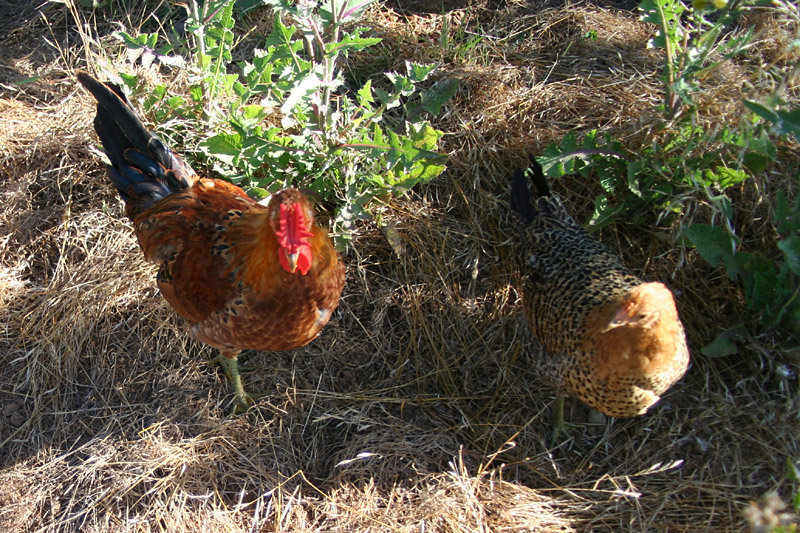
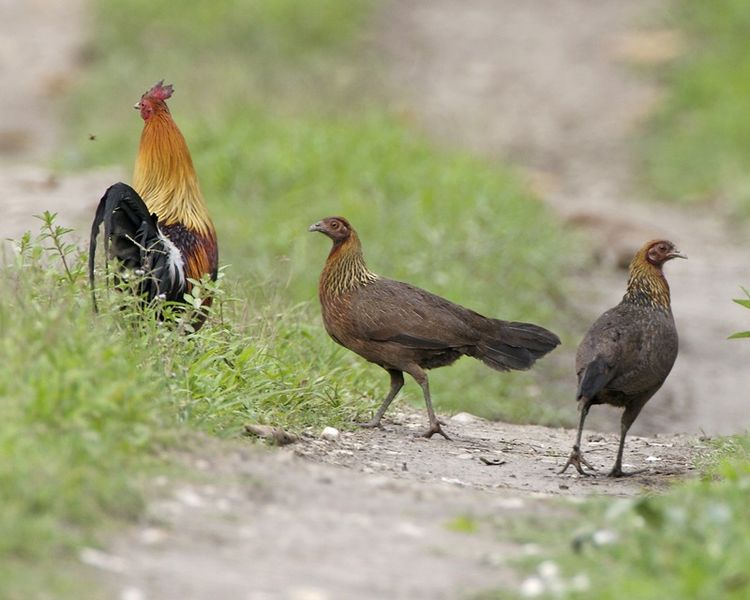 The Red Junglefowl (Gallus gallus) is a tropical member of the Pheasant family. It is thought to be ancestral to the domestic chicken, with some hybridisation with the Grey Junglefowl. The Red Junglefowl was first domesticated at least five thousand years ago in Asia, then taken around the world, and the domestic form is kept globally as a very productive food source of both meat and eggs.
The Red Junglefowl (Gallus gallus) is a tropical member of the Pheasant family. It is thought to be ancestral to the domestic chicken, with some hybridisation with the Grey Junglefowl. The Red Junglefowl was first domesticated at least five thousand years ago in Asia, then taken around the world, and the domestic form is kept globally as a very productive food source of both meat and eggs.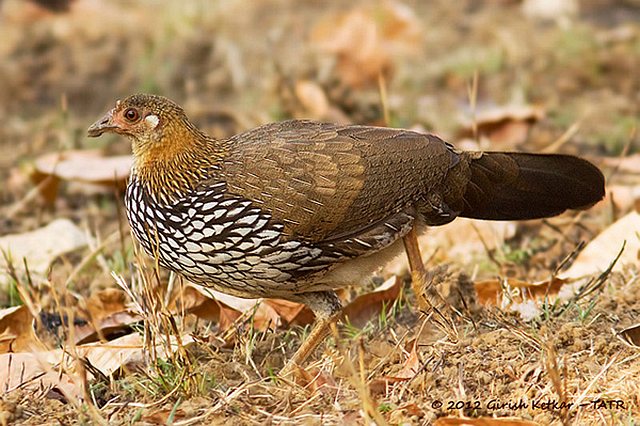
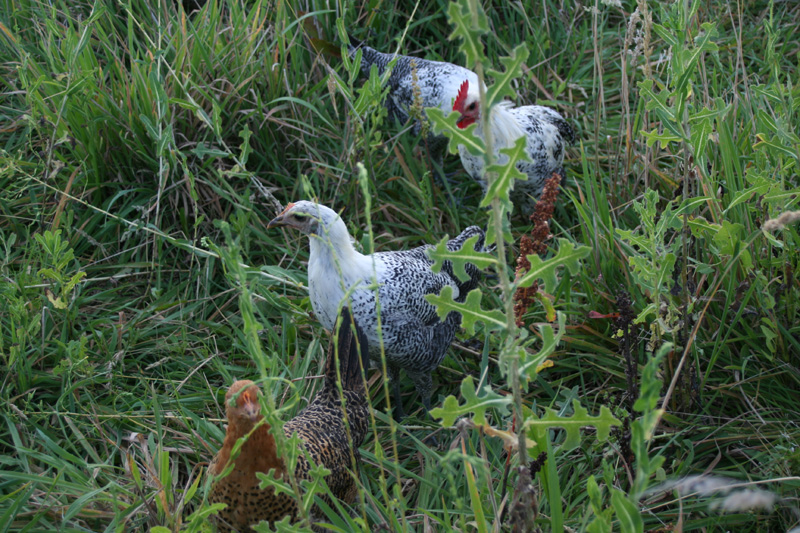 delightful article worth your time:
delightful article worth your time: 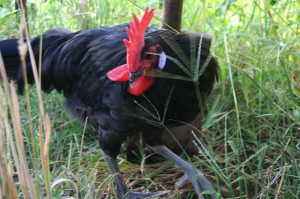
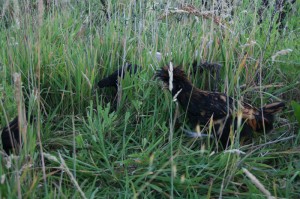 – you MUST have space and hiding places if you have more than 1 rooster, or 2 or 3 who might not get along. Sometimes it is so clear and accepted who is boss, they might be ok with more than 1. This is a MUST, the space thing. I had to let them out and free range in the garden, which they needed, even though they don’t actually go all that far. Depending on your set up and preferences, it will be better to fence in the actual vegetable garden part and let them be everywhere else than fence them into too small a space.
– you MUST have space and hiding places if you have more than 1 rooster, or 2 or 3 who might not get along. Sometimes it is so clear and accepted who is boss, they might be ok with more than 1. This is a MUST, the space thing. I had to let them out and free range in the garden, which they needed, even though they don’t actually go all that far. Depending on your set up and preferences, it will be better to fence in the actual vegetable garden part and let them be everywhere else than fence them into too small a space.